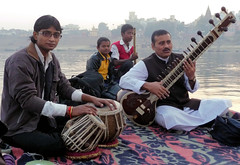The sitar is long-necked, guitar-like instrument which makes a complex, droning and twinkling melody.
It has been played since the Middle Ages, says Wikipedia. It derives its sound from sympathetic strings (which are under the arched frets, amazingly), a long hollow neck and a gourd resonating chamber.
There may be up to 21 strings. Typical woods used in the construction include mahogany and teak. The body is based on a gourd which is carefully carved.
Tabla are a pair of hand drums of contrasting sizes and timbres. The term tabla is derived from an Arabic word, tabl, which simply means "drum." [1]
The heel of the hand is used to apply pressure or in a sliding motion on the larger drum so that the pitch is changed during the sound's decay.
The bāyāñ, the larger of the pair, has a much deeper bass tone, much like its distant cousin, the kettle drum. The bāyāñ may be made from brass - the most common - or copper, which is more expensive, but generally held to be the best, while aluminum and steel are often found in inexpensive models. One sometimes finds that wood and clay are also used.
The head of each drum has an inner spot called the syahi (lit. "ink"; a.k.a. shāī or gāb). This is constructed using multiple layers of a tuning paste made from starch (rice or wheat) mixed with a black powder of various origins. The precise construction and shaping of this area is responsible for modification of the drum's natural overtones, resulting in the clarity of pitch and variety of tonal possibilities unique to this instrument.
skip to main |
skip to sidebar
For students and parents who love education and exploration of the social sciences . . .
Search This Blog
Followers
Blog Archive
-
▼
2010
(346)
-
▼
March
(51)
- What's surprising and significant in the compariso...
- Thurs, Ap 1: Vietnam plus Korea map quiz as well a...
- Korea: another nation divided between communist an...
- Orienting ourselves to the Pacific rim nations
- Review of Presidents in Vietnam project
- Thanks for supporting the Class of 2013 Magnet Tal...
- Informal presidential review . . .
- Vietnam: 58,000 US dead, some 4 million Vietnamese...
- 1972, South Vietnam: the Victims Of War
- Shot Heard Around The World: Execution of a Viet C...
- Due Thurs: Colorful map of Vietnam
- Vietnam and the Chinese, French and the US: a hist...
- In-class project: Four presidents and US involveme...
- The largest and most technologically advanced ship...
- Indie work: briefly compare the war in Iraq and Vi...
- Vietnam veteran interview due Mon, Ap 5; 15 pts
- Washington to Hanoi: Vietnam review
- Sitar & Tabla: the unusual musical instruments of ...
- Indie work deadline Sun, Mar 14, noon, for this 9 ...
- Eric Johnson's Gandhi project: effective digital d...
- Freshman Talent Show: Wed, Mar 24, 6:30 pm, PAC; i...
- Shreveport's Hindu Cultural Center since 2006
- Western world stress relief: Hatha Yoga from India
- Gandhi's tactics: use media, the law, Christianity...
- Watching the movie Gandhi for useful quotes . . .
- India: land of many cuisines
- Gandhi map project due Thurs; 15 pts
- Sari vs kimono and other indie comparison topics
- The 78-year journey of Mohandas Karamchand Gandhi
- Mumbai / Bombay: one of the world's most populous ...
- Slumdog Millionaire and other recommended movies o...
- India: Land of Curry, land of Hinduism
- Indie work: comparison essays on . . .
- The Ankh: symbol of eternal life
- March named for Roman god of war & fertility: Mars
- Pharaoh Hatshepsut, female ruler about 1500 BCE of...
- Egyptian overview: from the Pharaonic period to th...
- What to know on a map of Aegypticus (the Roman/Lat...
- A highlighter: the tool to use as you review notes...
- Egypt map and textbook activities
- The Nile
- West African music
- West African studies
- Walk like an Egyptian, The Bangles
- Gift of the Nile: Egypt
- Abu Simbel: massive mountainside temples in Southe...
- Memphis was the first capital of Egypt
- The columns of the Luxor Temple, near Karnak
- The Great Pyramids were built during the Old Kingdom
- Sphinxes
- The Great Pyramid of Giza (of Khufu), the Great Sp...
-
▼
March
(51)

